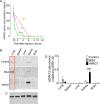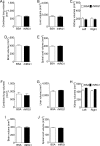Neuregulin-1 Administration Protocols Sufficient for Stimulating Cardiac Regeneration in Young Mice Do Not Induce Somatic, Organ, or Neoplastic Growth
- PMID: 27175488
- PMCID: PMC4866786
- DOI: 10.1371/journal.pone.0155456
Neuregulin-1 Administration Protocols Sufficient for Stimulating Cardiac Regeneration in Young Mice Do Not Induce Somatic, Organ, or Neoplastic Growth
Abstract
Background: We previously developed and validated a strategy for stimulating heart regeneration by administration of recombinant neuregulin (rNRG1), a growth factor, in mice. rNRG1 stimulated proliferation of heart muscle cells, cardiomyocytes, and was most effective when administration began during the neonatal period. Our results suggested the use of rNRG1 to treat pediatric patients with heart failure. However, administration in this age group may stimulate growth outside of the heart.
Methods: NRG1 and ErbB receptor expression was determined by RT-PCR. rNRG1 concentrations in serum were quantified by ELISA. Mice that received protocols of recombinant neuregulin1-β1 administration (rNRG1, 100 ng/g body weight, daily subcutaneous injection for the first month of life), previously shown to induce cardiac regeneration, were examined at pre-determined intervals. Somatic growth was quantified by weighing. Organ growth was quantified by MRI and by weighing. Neoplastic growth was examined by MRI, visual inspection, and histopathological analyses. Phospho-ERK1/2 and S6 kinase were analyzed with Western blot and ELISA, respectively.
Results: Lung, spleen, liver, kidney, brain, and breast gland exhibited variable expression of the NRG1 receptors ErbB2, ErbB3, ErbB4, and NRG1. Body weight and tibia length were not altered in mice receiving rNRG1. MRI showed that administration of rNRG1 did not alter the volume of the lungs, liver, kidneys, brain, or spinal cord. Administration of rNRG1 did not alter the weight of the lungs, spleen, liver, kidneys, or brain. MRI, visual inspection, and histopathological analyses showed no neoplastic growth. Follow-up for 6 months showed no alteration of somatic or organ growth. rNRG1 treatment increased the levels of phospho-ERK1/2, but not phospho-S6 kinase.
Conclusions: Administration protocols of rNRG1 for stimulating cardiac regeneration in mice during the first month of life did not induce unwanted growth effects. Further studies may be required to determine whether this is the case in a corresponding human population.
Conflict of interest statement
Figures










Similar articles
-
Neuregulin stimulation of cardiomyocyte regeneration in mice and human myocardium reveals a therapeutic window.Sci Transl Med. 2015 Apr 1;7(281):281ra45. doi: 10.1126/scitranslmed.aaa5171. Sci Transl Med. 2015. PMID: 25834111 Free PMC article.
-
ERBB2 triggers mammalian heart regeneration by promoting cardiomyocyte dedifferentiation and proliferation.Nat Cell Biol. 2015 May;17(5):627-38. doi: 10.1038/ncb3149. Epub 2015 Apr 6. Nat Cell Biol. 2015. PMID: 25848746
-
Improving murine embryonic stem cell differentiation into cardiomyocytes with neuregulin-1: differential expression of microRNA.Am J Physiol Cell Physiol. 2011 Jul;301(1):C21-30. doi: 10.1152/ajpcell.00141.2010. Epub 2011 Mar 30. Am J Physiol Cell Physiol. 2011. PMID: 21451102 Free PMC article.
-
Neuregulin1 as novel therapy for heart failure.Curr Pharm Des. 2011;17(18):1808-17. doi: 10.2174/138161211796391010. Curr Pharm Des. 2011. PMID: 21631420 Review.
-
The role of neuregulin/ErbB2/ErbB4 signaling in the heart with special focus on effects on cardiomyocyte proliferation.Am J Physiol Heart Circ Physiol. 2012 Jun 1;302(11):H2139-47. doi: 10.1152/ajpheart.00063.2012. Epub 2012 Mar 16. Am J Physiol Heart Circ Physiol. 2012. PMID: 22427524 Free PMC article. Review.
Cited by
-
Tumor-treating fields induce autophagy by blocking the Akt2/miR29b axis in glioblastoma cells.Oncogene. 2019 Sep;38(39):6630-6646. doi: 10.1038/s41388-019-0882-7. Epub 2019 Aug 2. Oncogene. 2019. PMID: 31375748
-
ErbB2 signaling at the crossing between heart failure and cancer.Basic Res Cardiol. 2016 Nov;111(6):60. doi: 10.1007/s00395-016-0576-z. Epub 2016 Sep 5. Basic Res Cardiol. 2016. PMID: 27596216 Free PMC article. Review.
-
Transcriptional Programs and Regeneration Enhancers Underlying Heart Regeneration.J Cardiovasc Dev Dis. 2018 Dec 22;6(1):2. doi: 10.3390/jcdd6010002. J Cardiovasc Dev Dis. 2018. PMID: 30583498 Free PMC article. Review.
-
The Role of Neuregulin-1 in Steatotic and Non-Steatotic Liver Transplantation from Brain-Dead Donors.Biomedicines. 2022 Apr 23;10(5):978. doi: 10.3390/biomedicines10050978. Biomedicines. 2022. PMID: 35625715 Free PMC article.
-
Adult Cardiomyocyte Proliferation: a New Insight for Myocardial Infarction Therapy.J Cardiovasc Transl Res. 2021 Jun;14(3):457-466. doi: 10.1007/s12265-020-10067-8. Epub 2020 Aug 20. J Cardiovasc Transl Res. 2021. PMID: 32820393 Review.
References
-
- Burns KM, Byrne BJ, Gelb BD, Kuhn B, Leinwand LA, Mital S, et al. New mechanistic and therapeutic targets for pediatric heart failure: report from a National Heart, Lung, and Blood Institute Working Group. Circulation. 2014;130(1):79–86. Epub 2014/07/02. 10.1161/CIRCULATIONAHA.113.007980 . - DOI - PMC - PubMed
Publication types
MeSH terms
Substances
Grants and funding
LinkOut - more resources
Full Text Sources
Other Literature Sources
Medical
Research Materials
Miscellaneous

